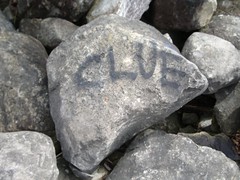I’m taking a bloggy vacation this week, so we’ll resume this series when I get back! Other posts scheduled later this week, too!
In a mystery, a clue—or at least its definition—is obvious: it’s a little fact that, along with all the others, adds up to finding the murderer and his/her motive and opportunity. These clues include objects at (or from) the crime scene, objects or information relating to the victim or killer, and interactions with the as-yet-unknown killer, as well as red herrings, clues pointing to an innocent but viable suspect, or clues that seem to prove the innocence of the real killer.
These clues include objects at (or from) the crime scene, objects or information relating to the victim or killer, and interactions with the as-yet-unknown killer, as well as red herrings, clues pointing to an innocent but viable suspect, or clues that seem to prove the innocence of the real killer.
In a work that isn’t a murder mystery or thriller, however, there’s often still a central mystery or question that isn’t answered until an important point in the plot: a secret revealed at a key moment, a reversal, a shapeshifter (archetypal, not literal) unmasked, etc. And of course, there’s usually a central element of mystery in the plot: what will happen? These mysteries are the kind of thing that you might mention with a *SPOILER ALERT* warning first (just like you would in a regular mystery).
And just like in mysteries, clues are again the little events, objects, or information that foreshadow the coming revelation: clues that show us a character isn’t who she says she is, a hint that an ally or a rival knows more than they’re letting on, or even just an unusual event or object that the POV character notices (just barely).
The balancing act with all clues is difficult because if we draw too much attention to them, we run the risk of giving away the mystery. A less serious risk would be overplaying the mystery—for minor reveals, if we include too much buildup, the “payoff” of the reveal will be less satisfying.
On the other hand, if we bury the clues too well—or neglect to include them at all—the reader feels like the rug was pulled out from under him. The reader goes from the surprise an author is aiming for right to betrayal.
With this series, we’ll look at several methods of burying these clues, so that our reader notices them just enough, and try to address how much is just enough.
What do you think? What kind of “clues” do you use?
Photo by Paul Kohler


I wish I was clever at this. I think Jo Rowling is fabulous at the “things hidden in plain site” and I’m impressed with Brandon Sanderson, who does it really well. I love when an author managed to slip in little tidbits or details within a casual comment in a seemingly innocuous scene that we don’t realize is a little gem, unless we’re Sherlock Holmes or Hermione Granger. =D